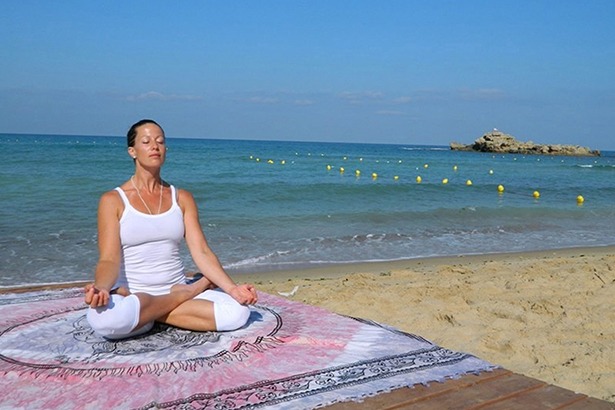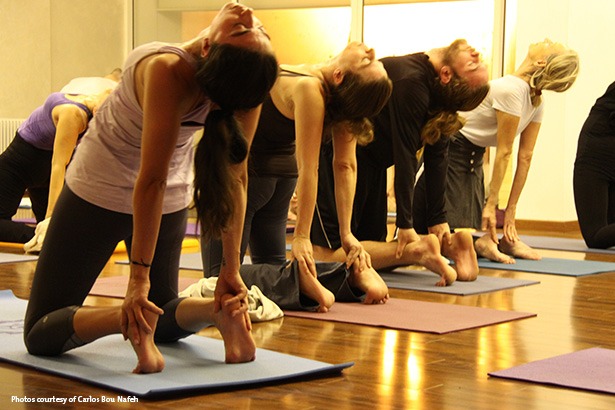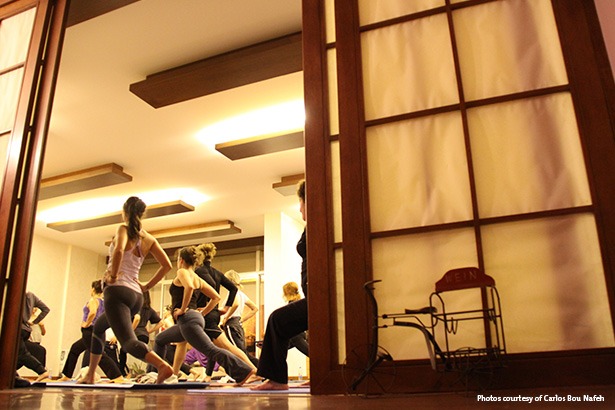In these challenging times, yoga has become a powerful way for people in Lebanon to de-stress, find peace, and reconnect with themselves. Whether it’s for physical health or mental clarity, its benefits are truly profound.
What is Yoga?
Yoga is an ancient Indian body of knowledge. The Sanskrit word yoga means to join or yoke together. Ancient yogis had a belief that in order for a person to be in harmony with oneself and ones environment, the person has to integrate the body, the mind and the soul. For these three to be integrated, emotion, action and intelligence must be in balance.
Yoga, as its name indicates, aims to unite body and mind in a unique harmonious experience. Exercise, breathing and meditation are the three main axes of yoga. Designed to put pressure on the glandular systems of the body, the exercises can lead to health improvement. Breathing techniques are based on the concept that breath is the source of life in the body. Students gently increase breath control to improve the health and function of both body and mind. By focusing on these two, students are prepared for the next step: meditation. By designing physical poses and breathing techniques that develop awareness of the body, Yoga allows students to focus and be relieved from the daily stresses.

What Are the Benefits of Yoga?
The practice of yoga can be beneficial on many levels, both physically, spiritually and emotionally.
Stress reduction
The modern daily lifestyle is not one free of stress. Yoga, with its quiet, precise movements will drive your focus away from the chaos of your day towards a calm place as you move your body through poses that require balance and concentration.
Increased fitness
As you learn the many yoga positions and master balance techniques, you will enjoy an improved range of motion and strength as well as enhanced flexibility. This increased fitness means a decreased risk of injuring yourself in other physical activities of your daily routine.
Better posture
With increased flexibility and strength comes better posture as most standing and sitting poses of yoga develop core strength as you are counting on your abdominals to support and maintain each pose. Exercise will heighten your body awareness which means you are more likely to realize when you are slouching or slumping and adjust yourself into the right posture.
Healthier circulation
Yoga improves blood circulation. By transporting nutrients and oxygen throughout your body, yoga provides healthier organs, skin and brains.
Better pain tolerance
Yoga students have a higher pain tolerance than people who do not practice yoga on regular basis. Studies have revealed that meditation increases the thickness of the grey matter in brain therefore reducing your sensitivity to pain.
Management of chronic health conditions
Yoga might help with a variety of health conditions such as cancer, depression, pain, anxiety and insomnia by helping with sleep problems, fatigue and mood. It can also help reduce heart rate and blood pressure, which will lead to lesser risks of heart attacks, high blood pressure and strokes.
Weight loss
For overweight and binge eaters, yoga might facilitate to make the healthy lifestyle changes that will help gain control of your eating habit, hence loose the unwanted kilos.

Yoga for travelers
Travel can be physically and mentally taxing. Incorporating yoga into your travels can help you enjoy the journey instead of stressing out. Below are a few poses that will allow you relieve your fatigue so you can fully enjoy our beautiful country! Be sure not to push yourself too hard in the poses. Take it easy, remember to breathe and have fun.
Pose 1
Restorative Inversion: Legs up against the wall
This position stretches the back of the legs, calms the mind, and relieves fatigue and cramping in the legs and feet.
- Set a bolster or pillow on the floor against the wall.
- Sit sideways against the wall with your lower back against the bolster.
- Gently bring your legs up onto the wall. Use your hands for balance as you shift your weight as you lie down.
- Rest your shoulders and head on the floor. Your lower back should now be fully supported by the bolster.
- Hold for 5-10 minutes, breathing with awareness.
- To release, slowly push yourself away from the wall and slide your legs to the side.
Pose 2
Spine Opener: Bridge Pose
The bridge pose calms the mind and is known to be therapeutic for individuals with high blood pressure. Do not perform this pose if you have neck injuries.
- Lie on your back with your knees bent and feet on the floor.
- Press your feet and arms into the floor as you lift your hips toward the ceiling.
- Keep your thighs and feet parallel — do not roll to the outer edges of your feet or let your knees drop together. Roll your shoulders back and underneath your body. Clasp your hands and extend your arms along the floor beneath your pelvis.
- Hold for up to one minute, then exhale and release by slowly rolling the spine along the floor, vertebra by vertebra.
Pose 3
Spinal Stretch: Easy pose with twist
This position stretches the back, knees, and ankles. Sitting upright so your spine is properly aligned reduces stress and anxiety. Twisting stimulates and detoxifies your abdominal organs, while boosting energy.
- Sit on the edge of a folded blanket, crossing your legs in front of you at the shins. If your hips are very tight, you can sit on a bolster or block.
- Balance your weight evenly across your sit bones. Align your head, neck, and spine. Lengthen your spine, but soften your neck. Relax your feet and thighs.
- Place your right hand on the floor behind you. Bring your left hand to the outside of your right knee, gently twisting to the right. Inhale to lengthen your spine, and exhale to twist deeper. Gaze over your right shoulder.
- Hold for ten breaths.
- Come back to center. Change the cross of your legs and twist to the opposite side.
- To release, come back to center.
Pose 4
Restorative Stretch: Easy Pose with Forward Fold
This position stretches the back, shoulders, hips, knees and ankles. Folding forward calms the mind, and reduces anxiety and fatigue.
- Sit on the edge of a firm blanket, crossing your legs in front of you at the shins. If your hips are very tight, you can sit on a bolster or block.
- Balance your weight evenly across your sit bones. Align your head, neck, and spine. Lengthen your spine, but soften your neck. Relax your feet and thighs.
- Reach your arms up overhead, lengthening your spine.
- On an exhalation, slowly bow forward with your arms still extended. Rest your arms, hands, and forehead on the mat. If your forehead does not touch the mat, bend your elbows, stack your hands, and rest your forehead on your hands. You can also rest your forehead on a pillow or bolster.
- Hold for up to five minutes.
- To release, use your hands to walk yourself back to an upright, seated position. Change the cross of your legs, and repeat the pose.
Pose 5
Full-body Stretch: Seated Forward Fold
This calming forward bend helps to relieve stress and reduce fatigue. It stretches the spine, shoulders, and hamstrings, and is reputed to be therapeutic for high blood pressure and infertility.
- Do not perform this pose if you have a back injury.
- Sit on the edge of a firm blanket with your legs extended in front of you. Beginners should bend the knees throughout the pose, eventually straightening the legs as flexibility increases.
- Inhale as you reach your arms out to the side, and then up overhead, lengthening your spine.
- Exhaling, bend forward from the hip joints. Do not bend at the waist. Lengthen the front of your torso. Imagine your torso coming to rest on your thighs, instead of tipping your nose toward your knees.
- Hold onto your shins, ankles, or feet — wherever your flexibility permits. You can also wrap a yoga strap or towel around the soles of your feet, holding it firmly with both hands. Keep the front of your torso long; do not round your back. Let your belly touch your legs first, and then your chest. Your head and nose should be the last to touch your legs.
- With each inhalation, lengthen the front torso. With each exhalation, fold a bit deeper.
- Hold for up to one minute. To release the pose, draw your tailbone towards the floor as you inhale and lift the torso.

If you liked reading this, check out our article on our favorite spas in Lebanon.
Loading


